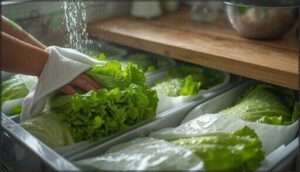This site is supported by our readers. We may earn a commission, at no cost to you, if you purchase through links.

Lettuce doesn’t wait for you to figure out the perfect harvest moment. Miss the window by a few days, and those crisp leaves turn bitter or bolt into towering flower stalks. Timing matters more than most gardeners realize—harvesting too early leaves flavor on the table, while waiting too long transforms your greens into a disappointing salad no one wants to eat.
The difference between great lettuce and mediocre leaves often comes down to recognizing the right signs and using proper technique. Head varieties need a firm squeeze test, loose-leaf types show readiness through color intensity, and romaine displays its dark green signal when conditions align.
Once you understand how to read your plants and match your method to the variety, you’ll harvest lettuce that stays fresh longer and tastes better than anything you’ll find at the store.
Table Of Contents
- Key Takeaways
- When is Lettuce Ready to Harvest?
- Harvesting Methods for Different Lettuce Types
- Step-by-Step Lettuce Harvesting Techniques
- Maximizing Yield and Extending Harvest
- Proper Post-Harvest Handling and Storage
- Frequently Asked Questions (FAQs)
- When to harvest cut and come again lettuce?
- Can you harvest lettuce in wet conditions?
- What happens if you harvest lettuce too early?
- Should you wash lettuce immediately after harvesting?
- How do you know when romaine is ready?
- Can harvested lettuce regrow from cut stems?
- Can you harvest lettuce in the rain?
- How does soil type affect lettuce harvest?
- What causes bitter-tasting lettuce leaves?
- Should you fertilize right after harvesting lettuce?
- Conclusion
Key Takeaways
- Harvest timing depends on variety—head lettuce needs a firm squeeze test at 6-12 inches tall, loose-leaf shows readiness through vibrant dark green color, and romaine displays its peak with a solid heart and glossy foliage between 60-70 days after planting.
- The cut-and-come-again method for loose-leaf varieties lets you harvest outer leaves repeatedly (3-6 times per plant) by cutting at a 45-degree angle 1/4 to 1/2 inch from the base, which preserves the crown and extends your harvest for months instead of weeks.
- Morning harvest before 8 a.m. when temperatures sit around 60°F locks in moisture and preserves crispness—then immediate cooling through cold water rinse and storage at 32-36°F with 90-95% humidity keeps leaves fresh for up to three weeks.
- Preventing bolting requires temperature management below 80°F using shade cloth or timing adjustments, choosing bolt-resistant varieties, and harvesting promptly when plants mature, since bolting triggers bitterness and ends your harvest window.
When is Lettuce Ready to Harvest?
Knowing when to harvest your lettuce makes all the difference between crisp, flavorful greens and leaves that have turned bitter or tough. The timing depends on the variety you’re growing and what you’re looking for in taste and texture.
Let’s walk through how to recognize when your lettuce has reached its peak.
Recognizing Mature Lettuce Varieties
Before harvesting lettuce, you’ll need to recognize when different varieties reach maturity. Head lettuce types like iceberg and romaine develop firm, dense heads—generally 6 to 12 inches tall—that feel solid when gently squeezed. Loose-leaf varieties show mature leaves with vibrant, dark green coloration, while inner leaves turn lighter. Plant size and expected duration matter too:
- Head firmness: A tight, compact head signals readiness
- Leaf coloration: Deep green outer leaves with lighter centers indicate maturity
- Harvest window: Most varieties mature between 40 to 85 days after planting
Romaine lettuce displays a dark green color when it’s ready.
Signs of Optimal Harvest Time
Beyond firmness and coloration, best harvesting time shows up in multiple ways. Watch for leaves reaching 4 to 8 inches—a key growth stage indicator—with crisp, firm texture and vibrant leaf color.
Timing factors matter: harvest in the morning between 60°F and 70°F for best leaf quality. If you spot a tall stem shooting up, that’s bolting signals telling you to harvest immediately before bitterness sets in. Using garden scissors can ease the harvesting process.
Early Vs. Late Season Harvesting
Your growing season timing shapes both flavor and yield. Early season harvest brings sweeter, crisper leaves with better bolting resistance—you’ll get higher market prices and extended lettuce harvest potential.
Late season crops face summer heat challenges, increasing bolting risk and yield variations. Frost impact can damage leaves, making timing critical.
Harvest before temperature swings compromise quality, and you’ll get the most out of both taste and profit.
Harvesting Methods for Different Lettuce Types
Not all lettuce grows the same way, so your harvesting method should match the type you’re growing. Loose leaf varieties respond well to repeated cutting, while heading types need a different approach to avoid damaging the plant.
Let’s break down the best technique for each major lettuce category you’ll encounter in your garden.
Cut-and-Come-Again for Loose Leaf Lettuce
Loose leaf lettuce thrives when you harvest outer leaves regularly, leaving the crown intact for regrowth cycles. This cut-and-come-again method delivers fresh greens every 2 to 3 weeks, with each plant supporting 3 to 4 harvests per season.
Here’s how to boost your economic yield:
- Snip outer leaves at a 45-degree angle using sanitized pruning scissors for technique optimization
- Harvest during best conditions—early morning when leaves retain peak turgor pressure
- Cut 1/4 to 1/2 inch from the base to encourage new growth
- Plan harvesting frequency around heat waves to prevent bolting
This approach transforms 30 square feet into approximately $300 annually while reducing waste.
Harvesting Romaine and Butterhead Lettuce
Unlike loose leaf varieties, romaine and butterhead lettuce demand attention to maturity indicators—firm heads at 60 to 70 days for romaine, soft heads at 55 to 65 days for butterhead lettuce.
You’ll cut the base one inch above soil using sharp harvesting tools, or selectively harvest outer leaves for two to four cycles.
Mechanical harvesting now oversees large-scale operations, though post-harvest color fades faster in butterhead varieties.
Harvesting Head and Stem Lettuce
Head lettuce demands precision—you’ll harvest when heads are firm, usually 65 to 80 days after planting, cutting just above soil level with a sharp knife during dry afternoons to avoid wetness and rot.
For stem lettuce, wait until stems reach 20 to 30 cm, then cut below the lowest leaf. Separate damaged leaves immediately to preserve quality.
Step-by-Step Lettuce Harvesting Techniques
Once you know your lettuce is ready, the actual harvesting process matters just as much as timing. The method you choose, the tools you use, and even the time of day can affect both your harvest quality and how well your plants continue producing.
Let’s walk through the key techniques that will help you harvest lettuce like a pro.
Harvesting Outer Leaves Vs. Whole Plants
You can harvest lettuce two ways, and your choice shapes yield comparison and economic impact considerably.
The cut-and-come-again method targets outer leaves only, letting the plant regrow for weeks with minimal plant stress—boosting harvesting frequency up to six times per plant.
Whole-plant harvesting stops growth immediately but works when you’re ready to clear space or fight bolting.
Each method fits different garden goals.
Best Tools for Clean Cuts
Sharp knives or pruning scissors are your best bet for cutting lettuce leaves without bruising. A properly sharpened blade takes less than 10 seconds per head and preserves leaf quality. Scissor precision matters for loose-leaf types, while comfortable grips reduce strain during repeated cuts.
Tool sanitation between plants limits disease spread—sanitize blades after each session.
Robotic harvesters now assist large-scale operations, but home gardeners still rely on clean, manual harvesting techniques.
Picking Lettuce in The Morning
Cooler morning temperatures work in your favor when harvesting lettuce in the morning—field temps around 60°F slow respiration rates and preserve leaf quality. You’ll retain more moisture in the leaves, protecting nutrient preservation and crispness.
Commercial growers harvest before 8 a.m. in summer for good reason: that dew-covered lettuce stays fresh longer, giving you better texture and flavor with every harvest.
Morning harvests before 8 a.m. preserve lettuce freshness, locking in moisture for better texture and flavor
Maximizing Yield and Extending Harvest
Getting more lettuce from your garden isn’t just about when you harvest—it’s about how you plan and care for your plants throughout the season. A few smart strategies can keep fresh greens coming to your table for months instead of weeks.
Let’s look at three practical ways to increase your lettuce yield and stretch your harvest window.
Succession Planting Strategies
You can keep fresh lettuce coming to your table for months through successive planting. Here’s how to make it work:
- Planting intervals: Sow new seeds every 7–14 days, depending on whether you’re growing baby greens or full-size heads.
- Yield optimization: Staggered resowing increases total harvest by up to 30% compared to single plantings.
- Variety selection: Choose cultivars with different maturity rates—early, mid, and late season types—to naturally extend your lettuce harvest window.
- Planning tools: Use a garden calendar to track planting dates and estimated harvest times for each bed.
Crop integration matters too. Tuck lettuce transplants between slower-growing vegetables like cabbage to get the most out of garden space while extending your harvest season.
Preventing Bolting and Flower Stems
While succession planting keeps your beds productive, preventing bolting protects the harvest you’ve already grown. When temperatures climb above 80°F for several days, lettuce sends up a seed stalk and turns bitter.
Temperature management—through shade cloth or strategic planting timing—cuts bolting by up to 60%. Choose bolt-resistant varieties like Batavian types, maintain consistent watering control, and harvest promptly when plants mature to keep those flower stems from ruining your greens.
Encouraging Regrowth After Harvest
Beyond stopping bolts, you can multiply your harvest by preserving the crown during each cutting. The cut-and-come-again method targets outer leaves while leaving growth points intact, enabling lettuce plant regrowth through 2-3 cycles.
Post-harvest watering immediately after harvesting methods reduces stress, and light fertilizer aids regrowth cycles. Environmental factors like cool weather and tool sanitation improve extending lettuce harvest considerably.
Proper Post-Harvest Handling and Storage
Once you’ve harvested your lettuce, how you handle and store it makes all the difference in keeping those leaves crisp and fresh. Proper cooling, smart storage techniques, and even a simple trick for reviving wilted greens can extend your harvest’s shelf life by days or even weeks.
Let’s walk through the essentials of post-harvest care to help you get the most from your homegrown lettuce.
Cleaning and Cooling Lettuce Safely
Once you’ve picked your lettuce, washing protocols matter more than you might think. Rinse leaves under cold running water to remove dirt and reduce microbial risks—tap water alone cuts about 80% of bacteria.
For salad greens destined for the crisper drawer, cooling techniques are key: hydrocooling or dunking in cold, sanitized water lowers field heat fast while safe water and careful handling practices protect your harvest from contamination.
Storing Lettuce for Maximum Freshness
After cold running water has cleaned your greens, proper storing fresh lettuce begins. Place leaves in a plastic storage bag—perforated works best—wrapped loosely in paper towels to control humidity.
The ideal temperature sits between 32°F and 36°F in your crisper drawer, where 90–95% humidity control extends shelf life up to three weeks. Watch spoilage trends by avoiding ethylene-producing fruits nearby, and you’ll maintain that just-picked quality far longer than standard storage environment conditions allow.
Reviving Wilted Leaves
Even when lettuce loses its snap, you can bring it back. Cold water works like a charm—submerge wilted leaves for 15 to 30 minutes to restore up to 92% of their firmness. For faster results, try warm water at 120°F.
To get the most from revival:
- Trim the base by half an inch before soaking
- Separate leaves to increase water absorption
- Add a splash of vinegar to extend crispness
- Monitor water content changes—leaves should feel noticeably firmer
Cutting prep matters. When you remove damaged outer portions and soak separated leaves, you’ll see water content rise by 8–12% within half an hour.
After revival, wrap leaves in a tea towel, then store them in your crisper drawer. A quick rinse under cold running water removes any additives before serving. Measuring revival success is simple—if leaves feel crisp again, they’re ready to use.
Frequently Asked Questions (FAQs)
When to harvest cut and come again lettuce?
You can start harvesting cut-and-come-again lettuce when outer leaves reach 4 to 6 inches tall, about four to six weeks after sowing. Pick leaves in early morning for best freshness and crispness.
Can you harvest lettuce in wet conditions?
You shouldn’t harvest lettuce in wet conditions. Heavy rains increase contamination risks and disease incidence by promoting pathogen growth.
Wait at least 24 hours after rainfall before harvesting leaves to help achieve safer, higher-quality yields.
What happens if you harvest lettuce too early?
You might think pulling lettuce early saves time, but harvesting before maturity stunts growth stage development, leaves you with bitter taste, reduced nutrients, and immature leaves that face market rejection—hurting both quality and regrowth impact.
Should you wash lettuce immediately after harvesting?
Washing lettuce immediately after harvesting with clean water reduces microbial contamination by up to 90%.
However, you’ll need to dry leaves thoroughly before storage to prevent spoilage and extend shelf life in your crisper.
How do you know when romaine is ready?
Your romaine is ready when the leaves form a firm heart about 6 to 12 inches tall with dark green, glossy foliage.
Outer leaves can be picked earlier at 21 days for baby greens.
Can harvested lettuce regrow from cut stems?
Like saving leftovers in a Tupperware, you can regrow lettuce from cut stems using the cut-and-come-again method. Place stems in shallow water; new growth appears within days, though regrowth yield remains smaller than original heads.
Can you harvest lettuce in the rain?
You can harvest lettuce in the rain, but it’s not ideal. Rain increases disease risk and leaf damage.
For best plant health and water content, wait until leaves dry to minimize harvesting lettuce complications.
How does soil type affect lettuce harvest?
Think of soil as lettuce’s foundation—its texture, drainage, nutrient availability, and moisture directly shape plant growth and health.
Well-drained sandy loams with balanced salinity and rich soil microbiomes produce the most harvestable, vibrant greens.
What causes bitter-tasting lettuce leaves?
Bitter taste in lettuce stems from heat stress above 70°F, which triggers bolting and increases sesquiterpene lactones.
Water stress and nutrient imbalance also contribute, making bolting prevention and proper watering essential for sweet leaves.
Should you fertilize right after harvesting lettuce?
Fertilizing your lettuce plant right after harvest isn’t always the golden ticket to success. Proper nutrient timing depends on soil testing and growth stage—rushing fertilizer can risk over-application, while strategic plant care fosters new growth for maintaining plant production.
Conclusion
Your lettuce won’t send you a polite text reminder when it’s ready—it just bolts. Understanding the best way to harvest lettuce means you’ll catch those leaves at their peak, whether you’re snipping outer growth for weeks of salads or pulling entire heads when they’re firm.
Sharp tools, morning timing, and proper handling aren’t complications—they’re the difference between crisp greens and compost. Your garden rewards attention to detail.
- https://postharvest.ucdavis.edu/produce-facts-sheets/lettuce-romaine
- https://www.gardenary.com/blog/3-signs-your-romaine-lettuce-is-ready-to-be-harvested-from-the-garden
- https://fryd.app/en/magazine/harvesting-lettuce-how-to-do-it-right
- https://savvygardening.com/types-of-lettuce-to-grow/
- https://www.johnnyseeds.com/growers-library/vegetables/lettuce/lettuce-how-to-choose-grow-tips.html










